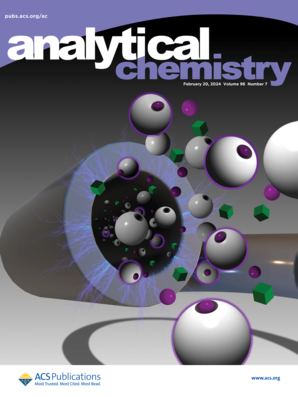Thin Layer Chromatography Goes Ultrasmall to Assay Sphingosine Kinase Activation in Single Primary Leukemic Cells
IF 6.7
1区 化学
Q1 CHEMISTRY, ANALYTICAL
引用次数: 0
Abstract
Cell-to-cell heterogeneity in lipid signaling underlies variations in response and recurrence for many cancers, including leukemias. A highly parallel, miniaturized thin-layer chromatographic platform capable of assaying single cells was developed. Ultrasmall volumes (50 pL) of standard fluorescent lipids were separated with excellent repeatability, reproducibility, and limits of detection. Sphingosine-cyanine 5 (Sph-Cy5) was loaded into cells, and the single-cell contents were separated to identify Sph-Cy5 and two metabolites, Sph-1-phosphate-Cy5 (S1P-Cy5) and hexadecanoic acid Cy5 (HA-Cy5). In leukemic cells, the CD34+ blast cells demonstrated significantly greater conversion of Sph-Cy5 to its phosphorylated form compared to that of the CD34- cells. After treatment with a sphingosine kinase (SphK) inhibitor, the level of formation of S1P-Cy5 remained significantly greater for the inhibited CD34+ cells relative to that of the inhibited CD34- cells. Over 1200 single cells were rapidly assayed using 8 chips within 4 h. Sphingosine kinase activity in the CD34+ blast cells of 3 patients with acute myeloid leukemia was assayed with and without inhibitors. The patient cells displayed intertumor and intratumor heterogeneity, and subsets of cells with distinct enzymatic activities and products, highlighting the diversity of the cells within a clinical sample and between patients.

求助全文
约1分钟内获得全文
求助全文
来源期刊

Analytical Chemistry
化学-分析化学
CiteScore
12.10
自引率
12.20%
发文量
1949
审稿时长
1.4 months
期刊介绍:
Analytical Chemistry, a peer-reviewed research journal, focuses on disseminating new and original knowledge across all branches of analytical chemistry. Fundamental articles may explore general principles of chemical measurement science and need not directly address existing or potential analytical methodology. They can be entirely theoretical or report experimental results. Contributions may cover various phases of analytical operations, including sampling, bioanalysis, electrochemistry, mass spectrometry, microscale and nanoscale systems, environmental analysis, separations, spectroscopy, chemical reactions and selectivity, instrumentation, imaging, surface analysis, and data processing. Papers discussing known analytical methods should present a significant, original application of the method, a notable improvement, or results on an important analyte.
 求助内容:
求助内容: 应助结果提醒方式:
应助结果提醒方式:


